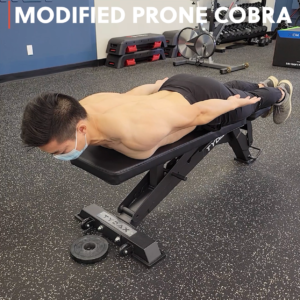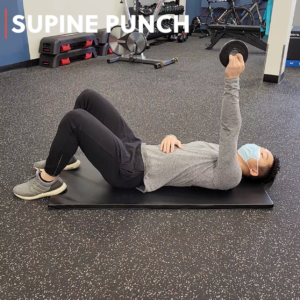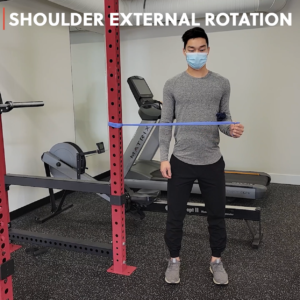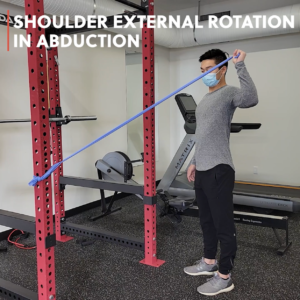
Reduce Your Risk of Shoulder Injury By Strengthening These 3 Muscle Groups
Training programs often emphasize large muscle groups through compound exercises like the bench press, lat pulldown and overhead press to focus on increasing strength and size. Smaller muscle groups around the shoulder complex that are needed for stabilization are often neglected, and imbalances in these areas can increase risk of impingement and instability. This blog post is based on evidence-informed recommendations by Escalante et al. (2020), published in the Strength and Conditioning Journal. The following exercises adapted from the article can be added to your routine to strengthen the stabilizer muscles in a progressive manner, and can decrease your chance of shoulder injuries like tendinosis, impingement and tears.
The exercises target three specific muscles or muscle groups in a progressive manner. The main purpose of these exercises is to learn how to activate one muscle/muscle group by itself while preventing other muscles from taking over. There is one basic exercise and one advanced exercise for each section. The advanced exercises should not be introduced until the basic ones can be performed with proper technique. Doing the advanced exercises before adequate control of isolated muscles is achieved may worsen muscle imbalances.
Lower Trapezius
The first muscle group to work on is the lower trapezius through scapular depression (bringing your shoulder blades down).
Begin with the modified prone cobra hold – this exercise is designed to activate the lower traps, without activating the lateral deltoids or upper traps (the muscles on the back of the shoulder and upper back). The goal of the exercise is to properly activate the lower traps, so resistance is not required. In a prone position and arms at the sides, reach the fingers towards the toes, initiating the movement by bringing your shoulder blade back and down. Hold this position for 10s, progressing to 30s over time, for 10 reps.

The following progression, prone scapular Y’s, maximizes lower trapezius activation, but recruits the upper trapezius and lateral deltoids as well. Starting on your stomach, raise the arm towards the ceiling at a 45 degree angle, with the thumb up and elbow fully extended. Do this for 12-20 reps for 3 sets. You can hold a 2.5-5lb weight for resistance to make it more challenging. You should be able to properly fire the lower traps before performing this exercise. Since this exercise also recruits the lateral deltoids and upper traps, existing imbalances can continue to develop if not done properly.

Serratus Anterior
The next muscle group to work on is the serratus anterior, which does protraction and external rotation of the scapula (moving the shoulder blades away from the spine).
The first exercise to isolate the serratus anterior is the supine punch. This will work on activating the serratus anterior, while minimizing firing of the upper trapezius. Lying with the back on the floor, start with the hand stacked on top of the shoulder and elbow extended. Punch and reach towards the ceiling. Do this for 12-20 reps for 3 sets, holding some weight in hand (2.5-10lb).

To progress loading of the serratus anterior, you can perform the push-up plus. In a push-up position with elbows fully extended, start with the shoulder blades retracted (pinched back together), then push the floor away and spread the shoulder blades. Perform this exercise in a slow and controlled manner for 10 reps and 3 sets.

Infraspinatus and Teres Minor
Similar to the previous exercises, the goal is to isolate the infraspinatus and teres minor, which perform external rotation and stabilize the overall shoulder complex.
Begin with the standing external rotation, with 0 degrees of abduction (elbow resting to the side). Tuck a small towel under the elbow to squeeze against, start with the palms facing inwards and forearm in contact with the belly. Keep the elbow tucked as you bring the back of the hand to the wall behind you, ending slightly past 90 degrees. Perform this for 3 sets of 12-20 reps.

To progress this exercise, the standing external rotation can be performed at 80 degrees of abduction (elbows raised away from sides). This exercise activates the lateral deltoids much more, so should only be introduced once the previous exercise can be performed properly.

Conclusion
The shoulder is a common site of injury for regular gym goers and athletes alike, in part due to disproportionate levels of strength between larger, stronger muscle groups (deltoids, upper trapezius, pectoralis major) and smaller stabilizer muscle groups (lower trapezius, serratus anterior, infraspinatus, teres minor). Routine strengthening of these stabilizer groups has shown to decrease the risk factors related to a shoulder complex injury like dislocations and bursitis.
References
Escalante, G., Fine, D., Ashworth, K., & Kolber, M. (2020). Progressive Exercise Strategies to Mitigate Shoulder Injuries Among Weight-Training Participants. Strength & Conditioning Journal, 43(1), 72-85.

